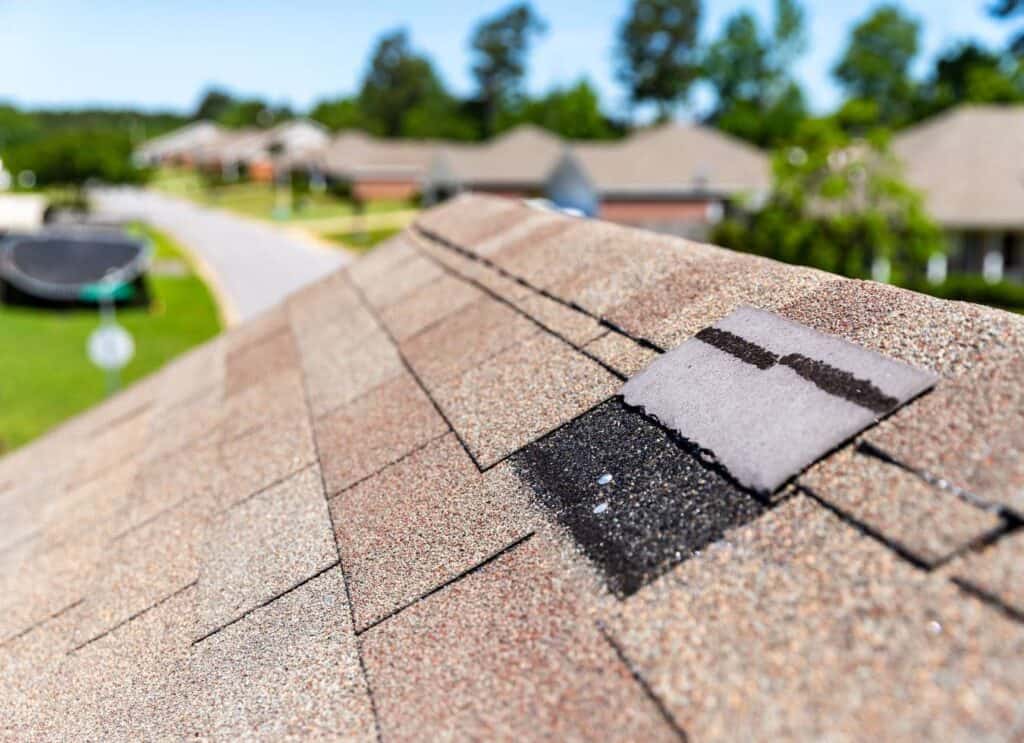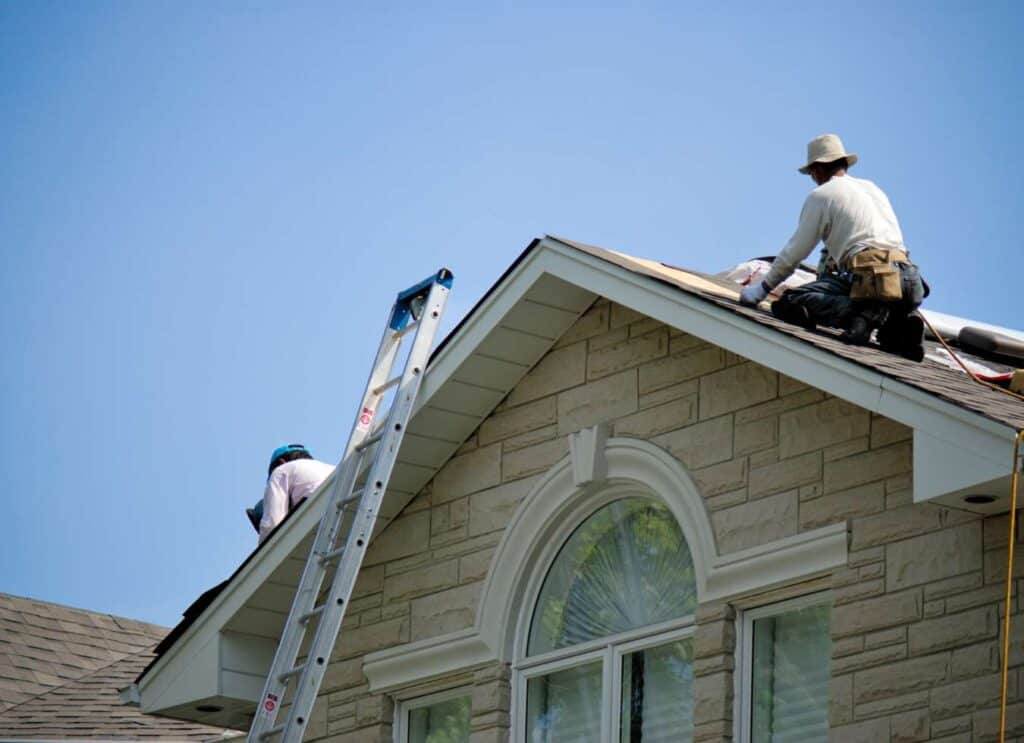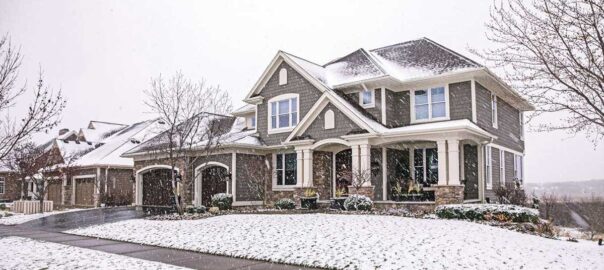So, you’ve just survived another one of Colorado’s famously unpredictable weather systems—hail, gusty winds, heavy snow, ice damming, or all of the above in one weekend. Your house is still standing, but now you’re left wondering: is your roof still in one piece? After all, your roof is your home’s first line of defense against the elements. Without knowing, you wouldn’t want a sneaky storm to have compromised your roof.
Whether you’ve just had a wild summer hailstorm or a blustery winter windstorm, it’s essential to inspect your roof as soon as possible for Damage from a severe storm that can compromise its integrity. Roof issues don’t always make their presence known immediately, so taking quick action after a storm can help you avoid more significant problems.
In this blog post, we’re breaking down everything you need to know to spot roof damage after a storm. We’ve created a checklist to help you navigate the inspection process, and we’ll walk you through common signs of storm damage and how to address them quickly. Trust us; your roof will thank you!

1. Start with a Visual Inspection
Okay, before you go all Sherlock Holmes on your roof, let’s be clear: we’re not asking you to scale the Everest-like peak of your roof without proper safety gear or experience. Safety is key, folks. Instead, grab your binoculars (don’t have them? Time to order on Amazon, my friend), stand back, and visually inspect your roof from the ground. Or look at the different sections of the roof from 2nd story windows if you have a multi-story home. This will give you a clear picture of the roof’s overall condition and allow you to spot any apparent damage.
Here’s what to look for during your visual inspection:
- Missing shingles: Missing roof shingles can lead to further issues if not addressed promptly. If you see patches of your roof without shingles, that’s a huge red flag. Those shingles were probably blown off after being pulled up during the storm.
- Curled or buckled shingles: Sometimes, they may not blow off entirely, but they might get bent, curled, or lifted. This can create vulnerable spots where leaks could form. This is either an age issue OR a ventilation issue.
- Granule loss: Asphalt shingles can lose granules after a storm, which makes them look blotchy or uneven. If your driveway is suddenly littered with granules (those gritty little pieces that give shingles their texture), it’s a sign your roof’s protection may be compromised.
- Sagging spots: A sagging roof could indicate severe structural damage requiring a new roof. While sagging can be caused by various factors, storm damage might be the culprit, mainly if it’s localized to certain areas.
- Dented or damaged metal roofing: If you have a metal roof, inspect it for dents, dings, or punctures. Hail can easily dent softer metals like aluminum, compromising the roof’s integrity.
- Damaged flashing: Flashing (the metal strips around chimneys, vents, and skylights) can get loose or even ripped off during high winds or storms. If you notice gaps or damaged flashing, water may be able to penetrate your roof.
- Fallen debris: After a storm, you might find branches, leaves, or even trees on your roof. If branches are heavy enough, they can puncture shingles or leave dents in the roof. Remove any debris, and inspect the affected areas closely for damage.
- Broken Skylights or Solar Panels: Broken skylights will be obvious. If the seal around the frame is damaged or compromised, you have stains inside the house. Solar Panels don’t get damaged very often by hail, but it CAN happen. Solar energy gets damaged by critters much more often than by big hail. And that is not covered by insurance.
2. Check for Leaks and Water Damage Indoors
Next, head inside your house to check for any signs of storm damage entering your home. Water infiltration can lead to mold, mildew, and wood rot, so don’t ignore these signs:
- Stains on ceilings or walls: A leak is one of the most obvious signs of roof damage. If you notice water stains on your ceiling, it could mean that rainwater is finding its way through cracks or holes in your roof. If left unchecked, these leaks can cause significant damage to your home’s interior.
- Wet attic insulation: If you have an attic, climb up there (safely, of course) and check for any dampness or damp insulation. If water has leaked through your roof, the insulation might be the first sign of damage. Wet insulation is also a breeding ground for mold, so it’s essential to address it quickly to avoid costly roof repair.
- Musty odors: If you smell something musty in the attic or upper floors of your home, this could be a sign of mold growth due to hidden leaks from the storm. If you suspect this, you’ll want to call a professional roofing contractor to inspect and treat the issue before it spreads. It’s not as common here on the Front Range; we see it occasionally. Most of the time, it’s an improperly vented attic, which can cause condensation under the right circumstances.
3. Inspect Gutters and Downspouts
Believe it or not, your gutters and downspouts can tell you a lot about the condition of your roof. After a storm, they’ll give you clues about the amount of debris or damage.
- Clogged gutters: If your gutters are packed with leaves, branches, or debris, it could indicate that the storm caused significant fallout from nearby trees. Clear out the debris, but while at it, check the gutters for any signs of damage. Are they bent, cracked, or pulled away from the house due to storm damage on your roof? Do your gutters or downspouts have round “dings” in them? Damaged gutters can lead to water pooling on your roof or spilling over and causing further leaks. Dings on the gutters can pool water over time and cause rust to form if the hail knocks off the enamel or missing downspouts. Check that your downspouts are still securely attached. If they’ve been knocked off or are loose, water may not be draining correctly, which could lead to roof and foundation damage.
4. Look for Storm-Related Damage to Surrounding Trees
After a storm, don’t just check your roof—walk around your property to check for potential dangers. Trees can cause a lot of damage to your roof, and if there’s a fallen branch or a leaning tree nearby, it’s worth checking for damage before it gets worse.
- Fallen branches or trees on the roof: This is a major red flag if you have large branches or whole trees. These kinds of impacts can cause extensive damage to shingles, metal panels, roof structures, soffits and fascia, gutters, and flashing. Call a professional to assess the situation and remove any debris safely.
- Loose or hanging branches: Even if there’s no immediate damage, remove branches near your roof to prevent potential wind damage. These branches could fall off during the next storm and cause severe damage to your roof.
5. Call a Professional for a Detailed Inspection
Once you’ve done your inspection, it’s always a good idea to call in a roofing professional like Denny’s Roofing for a more thorough professional inspection. Sure, you can spot the obvious stuff from the ground, but a pro will have the right tools, training, and safety equipment to assess your roof correctly. We can’t tell you how many homeowners don’t think they have hail damage only to find that they DO when a pro looks at the roof or your exterior after a big storm. Call us. Inspections are FREE.
Professional roofers can spot damage that might be difficult to notice from the ground, like structural issues or damage to the decking underneath the shingles. They’ll also have the expertise to know if your roof needs a quick repair or if significant damage requires a complete replacement.
If storm damage is extensive, your Denny’s Roofing professional can assist with roof repair. It can help you navigate the claims process with your insurance company. They’ll provide detailed assessments and estimates to ensure you get the coverage you deserve and be your advocate all along the way.
6. How to Address Roof Damage Quickly
If you do spot damage after a storm, it’s crucial to address it quickly to prevent further complications. Unaddressed roof damage can result in leaks, water damage, and more expensive repairs.
- Cover up leaks temporarily: If you see an active leak or a hole in the roof, cover it with a tarp or plastic sheeting until a roofing contractor can repair it. Or if it’s a real issue that could require a roof replacement. Call Denny’s Roofing and WE will come out and tarp your roof to ensure no additional damage. There is a right way and a wrong way to put a tarp on effectively.
- Document the damage: Take photos of the damage for insurance claims or your records. Having detailed pictures will help speed up the claims process.
- Call in the pros: A roofing professional can give you a more accurate damage assessment and recommend the next steps. If repairs are needed, don’t delay—the sooner you act, the better.

Other Popular Questions We Get About Roof Storm Damage and Common Signs of Roof Damage
Q: What are the five signs of storm damage on your roof?
A: The five signs of storm damage include missing or damaged shingles, granule loss, water stains on the ceiling, sagging areas, and signs of moisture penetration in your attic.
Q: How can I check for signs of storm damage on my roof?
A: You can check for signs of storm damage by visually inspecting your roof from the ground, using binoculars to look for missing shingles or granule loss, and checking your attic for leaks or water stains. Assessing the roof after heavy rain or high winds is also essential.
Q: What should I do if I find signs of storm damage on my roof?
A: If you find signs of storm damage, it’s crucial to document the damage with photos, check your homeowner’s insurance policy for coverage, and consider filing an insurance claim to cover the repairs.
Q: How does hail damage affect my roof?
A: Hail damage can lead to dents in roofing materials, granule loss, and even cracks, which may cause leaks if not addressed promptly. It’s essential to assess the extent of the damage after a hailstorm.
Q: What are the common types of roof damage after a storm?
A: Common types of roof damage after a storm include missing or broken shingles, leaks, sagging areas, and damage to the chimney or flashing. Each type of damage requires specific repair methods.
Q: How can I validate storm damage for my insurance claim?
A: To validate storm damage for your insurance claim, gather evidence such as photos, a damage checklist, and any relevant weather reports. This documentation will help support your claim regarding your homeowner’s insurance.
Q: What are the signs of moisture penetration in my attic?
A: Signs of moisture penetration in your attic include water stains on the ceiling, mold growth, and a musty smell. Checking your attic regularly can help identify these issues early.
Q: When should I consider replacing my roof due to storm damage?
A: You should consider replacing your roof if the damage is extensive, such as multiple missing shingles, significant sagging, or persistent leaks despite repairs. Consulting a roofing professional can help determine the best course of action.
Q: Can related articles help me understand storm damage better?
A: Yes, many related articles can provide further insights into assessing storm damage, understanding homeowners insurance coverage, and tips for maintaining your roof. These resources can help you navigate the process effectively.

Final Thoughts
Colorado’s weather is unpredictable, and your roof stands between you and the elements. After a storm, it’s crucial to take the time to check for damage and address it quickly to prevent further issues. Whether it’s missing shingles, leaks, or structural damage from a severe storm, acting fast can save you much money and stress in the long run.
If you spot any damage or want peace of mind, contact Denny’s Roofing for a professional roof inspection. We’re here to help you keep your roof in top shape, no matter what storm comes your way!
Need help after a storm? Contact Denny’s Roofing today for a free consultation and expert storm damage assessment!

